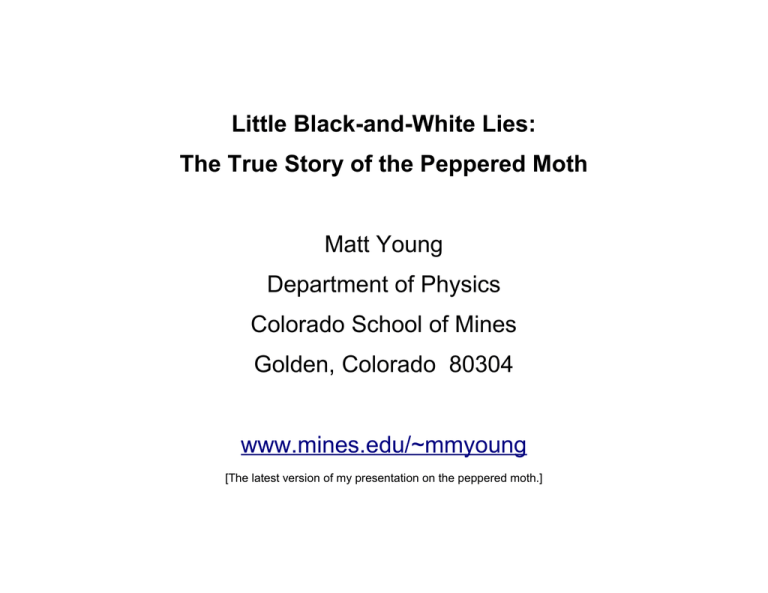Little Black-and-White Lies: The True Story of the Peppered Moth Matt Young
advertisement

Little Black-and-White Lies: The True Story of the Peppered Moth Matt Young Department of Physics Colorado School of Mines Golden, Colorado 80304 www.mines.edu/~mmyoung [The latest version of my presentation on the peppered moth.] The peppered moth (Biston betularia) Britain, mid-1800’s Air pollution, soot kill lichens, blacken trees Moths evolve black (melanic) form for camouflage 1950’s: Clean air acts Moths evolve back to light-colored (typica) form Hard to see on birch or lichen-covered trees Bernard Kettlewell’s studies, mid-50’s 1. Release─recapture experiments in woods Compared Industrial with rural, or Polluted with unpolluted habitats (Bruce Grant) Procedure Marked and released both melanic, typica moths Recaptured some in wee hours of next morning Used both optical and pheromone traps Results Polluted woods ― more melanic (+ insularia) Unpolluted woods ― more typica 2. Direct observation and filming Observed, filmed birds eating moths directly off tree trunks Enlisted (future) Nobelist Niko Tinbergen for photography Controversial result at time 3. Camouflage Visually rated camouflage of moths on different backgrounds Compared effectiveness of camouflage with predation rates In aviary In field Good correlation between camouflage and predation Despite birds having ultraviolet vision Moths may be camouflaged in the ultraviolet as well 4. Geographic distribution Distribution of melanic moths matched areas of industrialization Typica Melanic + insularia Industrial area (Kettlewell, 1959) Compare with rudimentary map of Wells (a) Proportion of melanics less than predicted (b) Melanism high despite lichens (c) Melanism increased after pollution control (d) Melanism decreases before lichens (?) Best discrepancy is actually Ireland, not shown And before and after maps by Bruce Grant Melanism: Evolution in Action Book by Michael Majerus, University of Cambridge Pointed out flaws in Kettlewell’s work Nevertheless defended Kettlewell, supported conclusions Review by Jerry Coyne, University of Chicago: "For the time being we must discard Biston as a wellunderstood example of natural selection in action." Creationists pounced! Wells’s Icons of Evolution Moths do not “normally” rest on trunks 25 % of the time they do, and anyway Birds hunt at all levels in canopy Photos of moths staged (but so are portraits), and anyway Majerus provides unstaged photos Typica reappeared before lichens reappeared, but anyway Trees lightened as soot decreased, Typica moths better camouflaged on clean trunks, branches, leaves than on sooty (lichens or no) Bird predation not only factor So, nu? Charges of fraud Of Moths and Men, 2002 Judith Hooper charges fraud: Sudden increase in recapture rate directly follows “threatening” letter from mentor But Moths released as they hatched from cocoons No control over hatching Letter to Kettlewell from E.B. Ford Received after increase in recapture rate “It is disappointing that the recoveries are not better ... However, I do not doubt that the results will be very well worth while ....” Hooper’s interpretation: “Now I do hope you will get hold of yourself and deliver up some decent numbers.” 7-year field study by Majerus Countered all of Hooper’s objections Released moths at dusk, into natural resting positions Used low density of moths Used only local moths Compared wild moths with lab-bred moths Confirmed Kettlewell’s results Can you see it? (Michael Majerus) Can you see it? Blind as a bat Hooper suggests differential bat – bat! – predation Yes, it would still be natural selection Majerus released moths into areas where bats feed Bats ate 208 typica, 211 melanic Coyne recants "I thought I was drawing attention to some problems and was doing the scientific community a service. I wasn't very clear. The key was well-understood." Review of Hooper’s book in Nature “... industrial melanism still represents a splendid example of evolution in action. ... No force other than selection could have caused such striking and directional change.” I get into the act What do physicists do? Devise models Perform uncertainty analyses Young’s law A number without a statement of uncertainty is worthless Young’s other law Some numbers are inherently worthless Soooo ... Physical model (Young and Musgrave, 2005) Draft of paper Estimated average 1- and 2-day recapture rates from data No. recaptured 40 y = 0.25 x r 2 = 0.80 30 20 10 0 0 50 No. released 100 Included effect of moonlight Recapture rate 0.4 y = -0.22 x + 0.30 r 2 = 0.75 0.3 0.2 (Exposure = 0.1 brightness × 0.0 time) 0.0 0.2 0.4 0.6 0.8 1.0 Relative exposure Recapture rate falls with increasing exposure to moonlight (optical traps) For experts: Calculated standard uncertainty of data points Binomial distribution: Variance, σ 2 = N p (1 – p) N = number of moths released on given night p = probability of recapture (recapture rate) u = σ = standard uncertainty Graph 95 % confidence interval, or ± 2 u Chi-squared test compared model with data p = 0.17, no moonlight; p = 0.75, with moonlight p < 0.05 if model were statistically different from data Error bars overlap both curves No. recaptured 50 40 30 20 10 0 0 5 Time, days 10 Data, model indistinguishable within standard uncertainty —— simple model, – – – model with moonlight Fast No page charges What Hooper believes Everything her informant Ted Sargent says Competing theory (induction) not accepted by experts Nothing Kettlewell says What Hooper does not understand Science Biology Vagaries of experimental science More erratic vagaries of field measurements Confirming evidence Kettlewell was first — a pioneer Made mistakes Work has been replicated In moths In other species In other locales Industrial melanism understood beyond reasonable doubt And is result of natural selection in peppered moths Conclusion All scientific experiments in some way flawed (All unscientific experiments too) Black-and-white thinkers (read: creationists) wrongly think Any mistake or discrepancy ≡ wholly wrong Cf. attacks by creationists on “Darwinism” Countless other studies support Kettlewell’s pioneering work Peppered moth properly remains icon of evolution Shameless self-promotion by author Coming soon: Why Evolution Works (and Creationism Fails) Matt Young and Paul Strode, Rutgers, 2009










